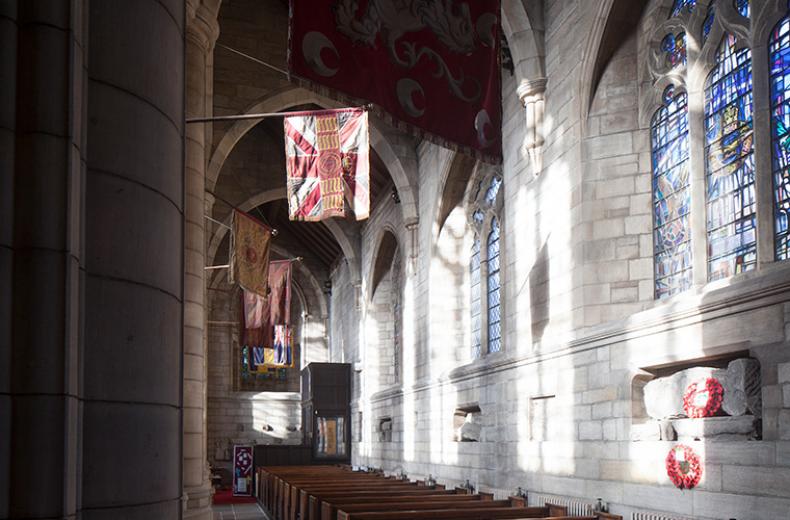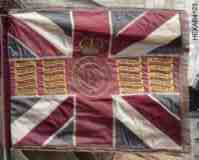Visitor Guide 16: Banners

The Hawick Banner is the first of the banners, furthest to the east. It commemorates a raid by Lord Dacre, Bailiff of Hexham, along with a number of Hexham men into Scotland in 1514. The Priory flag was captured by the Hawick Callants, a group of youths who defended the Scottish Borders town. The Banner on display is a replica presented to the Abbey in 1972 by the Provost of Hawick as a token of the friendship established between the two communities.
The far end of the aisle houses the British Legion Banners. The oldest of these Banners is the one housed in a glass case which dates from the 1920s when the Hexham Branch was formed. The other three British Legion Banners are the Women’s Section of the Hexham Branch, a Hexham Branch Banner hung in 2000 and the Northern Area, Northumberland County Banner hung in 1975.

On the formation of a new battalion, a ‘pair of colours’ is consecrated – the Sovereign’s colour (representing loyalty and patriotism) and the Regimental colour (representing local loyalty and self-sacrifice). Traditionally, when old colours are superseded, they are deposited in a Church and the Abbey is home to two pairs of these regimental banners.
The first belonging to the Scots Guards, presented to the 2nd Battalion in 1903 by Edward VII, and the other to the 4th Battalion Northumberland Fusiliers which were presented in 1920.
The Garter Standard of Viscount Allendale is another banner which hangs in the Abbey. The original was brought to Hexham Abbey from St George’s Chapel, Windsor in 1959 but in 2019 was deteriorating and replaced by a modern replica. The Viscount (1890-1956) was Lord of the Manor of Hexham and had a close association with the town, as did his father (who presented the Sele park to the people of Hexham) and his father before him).
The Banner of Sir Percy Loraine (1880-1961) was requested by Sir Percy to be hung in Hexham Abbey when it was removed after his death from St Paul’s Cathedral. Sir Percy became 12th Baronet of Kirkharle in 1917, he owned Styford Hall in Stocksfield and served as British High Commissioner to Egypt, and British Ambassador in Turkey and then in Italy.
The Millennium Banner, which hangs near the east end of the nave, was created to celebrate the arrival in Hexham of the third Christian millennium. It was the work of about forty members of Hexham Embroiderers’ Guild and was designed late in 1998.
The inspiration came from the name Hexham, which forms the central spine of the hanging, and the central panel was designed to show the key elements of the Hexham environment: wide Northumbrian skies; the high, rolling moorlands; planted forests, and the wooded valley of the Tyne; the town itself, dominated by the Abbey; Hexham people; and the River Tyne.
